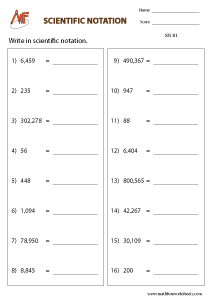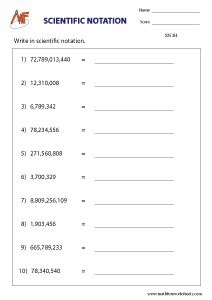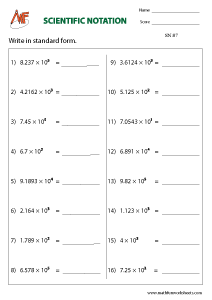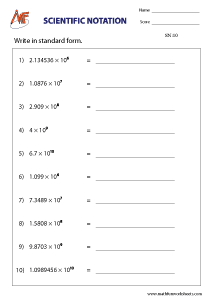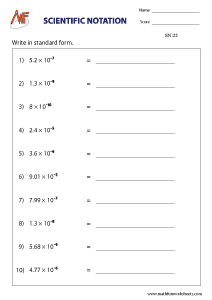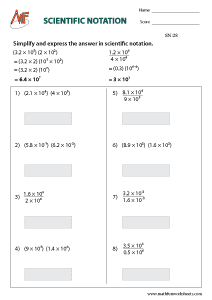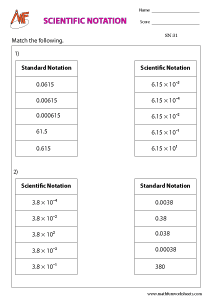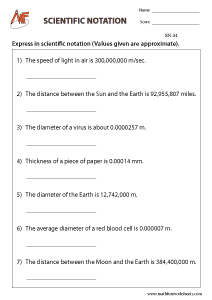Browse by Topics
- English Worksheets
- Science Worksheets
- Kid's Corner
- Numbers & Operations
- Addition
- Subtraction
- Multiplication
- Division
- Decimals
- Place Value
- Roman Numerals
- Skip Counting
- Odd & Even Numbers
- Patterns
- Cardinal & Ordinal Numbers
- Rounding Numbers
- Estimation of Numbers
- Estimation of Time & Money
- Counting & Cardinality
- Comparing Numbers
- Ordering Numbers
- Fractions
- Prime & Composite Numbers
- Squares & Cubes
- Square & Cube Root
- Divisibility Rules
- Factors & Multiples
- Data Handling
- Algebra
- Ratio
- Least Common Factor
- Greatest Common Factor
- Percent Worksheets
- Proportion
- Order of Operations
- Scientific Notation
- Exponents
- Algebraic Expressions
- Evaluating Algebraic Expressions
- Simplifying Algebraic Expressions
- Graphing Lines
- Point Slope Form
- Two Point Form
- Two Intercept Form
- Equations
- Identifying Functions
- Evaluating Functions
- Function Table
- Domain and Range
- Trigonometric Charts
- Quadrants
- Polynomials
- Measurement
- Geometry
- Word Problems
Scientific Notation Worksheets
Understanding scientific notation worksheets for grades 7 to 9 help students master the skill of expressing very large or very small numbers in a compact and efficient form. These worksheets break down the concept of scientific notation, making it easy for students to learn how to convert numbers to and from standard form. Through guided practice, students gain confidence and accuracy in handling numbers used in science, math, and technology.
In these worksheets, learn to express standard numbers in scientific form and scientific numbers in standard form. Also scientific notation Addition, Subtraction, Multiplication, and Division worksheets have been prepared for advanced learning.
RELATED ALGEBRA TOPICS : Order of Operations, Forming algebraic expressions and translating phrases
Let us learn how to express the numbers
The mass of earth is 5,970,000,000,000,000,000,000,000 kg. Such large numbers are represented using exponents. We represent it as 5.97 x 1024
Thus 10 is base here and 24 is the power in 5.97 x 1024
Lets us see how to represent it. Look into the number.
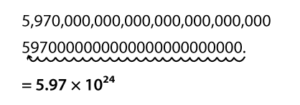 Place a decimal point at the end of the number. Now move the decimal 24 places to the left, such that you place the decimal point imediately after the first digit of the given number.
Place a decimal point at the end of the number. Now move the decimal 24 places to the left, such that you place the decimal point imediately after the first digit of the given number.
What does this expression 5.97 x 1024 mean?
5.97 x 1000000000000000000000000 (24 zeros)
OR
5.97 x 10 x 10 x 10 x 10 x 10 x 10 x 10 x 10 x 10 x 10 x 10 x 10 x 10 x 10 x 10 x 10 x 10 x 10 x 10 x 10 x 10 x 10 x 10 x 10.
Eg. Negative Integer
The size of a atom is 0.0000000008 m. We represent it as 8 x 10-10 m. Here you need to move the decimal point10 places right.

What does the expression 8 x 10-10 mean?
8 x 0.0000000001
OR
8 x 0.1 x 0.1 x 0.1 x 0.1 x 0.1 x 0.1 x 0.1 x 0.1 x 0.1 x 0.1
As the exponent decreases by 1, the value becomes one- tenth of the previous value.
Generally mathematicians, scientists and engineers deal with very large and very small numbers on daily basis. They also do exponent addition, subtraction, multiplication, and division. Here is an example for each operation.
When you add two or more exponents, the powers should be made equal first. Its is always better to convert the smaller power to the highest power.
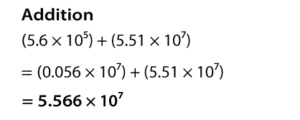
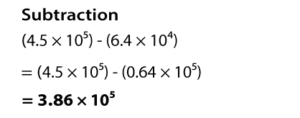 Just like addition, when you subtract exponents, the powers should be the same.
Just like addition, when you subtract exponents, the powers should be the same.
 When you multiply two exponents, just add the powers. am x an = am+n, where m and n are natural numbers.
When you multiply two exponents, just add the powers. am x an = am+n, where m and n are natural numbers.
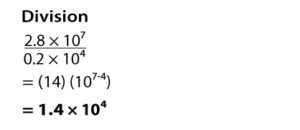
When you divide two exponents, subtract the powers. am/ an = am-n, where m and n are natural numbers.
Scientific Notation worksheets free download pdf
Positive Exponents - To Scientific - Up to 5

Positive Exponents - To Scientific - Up to 5
Positive Exponents - To Scientific - Up to 10

Positive Exponents - To Scientific - Up to 10
Positive Exponents - To Standard - Up to 5

Positive Exponents - To Standard - Up to 5
Positive Exponents - To Standard - Up to 10

Positive Exponents - To Standard - Up to 10
Negative Exponents - To Scientific - Up to 5

Negative Exponents - To Scientific - Up to 5
Negative Exponents - To Scientific - Up to 10

Negative Exponents - To Scientific - Up to 10
Negative Exponents - To Standard - Up to 5

Negative Exponents - To Standard - Up to 5
Negative Exponents - To Standard - Up to 10

Negative Exponents - To Standard - Up to 10
Express in Scientific form - Word Problems

Express in Scientific form - Word Problems
In addition, students work on multiplying and dividing numbers in scientific notation. These problems require applying exponent rules, which helps reinforce their algebraic thinking. As students solve more complex expressions, they build both accuracy and speed.
Many worksheets also include real-world scenarios, such as scientific data or distances in space. These examples show students how scientific notation is used outside the classroom, enhancing relevance and engagement.
In conclusion, these worksheets for grades 7 to 9 offer essential practice for building this critical math skill. With consistent use, students become comfortable with scientific notation and better prepared for high school science and math.

